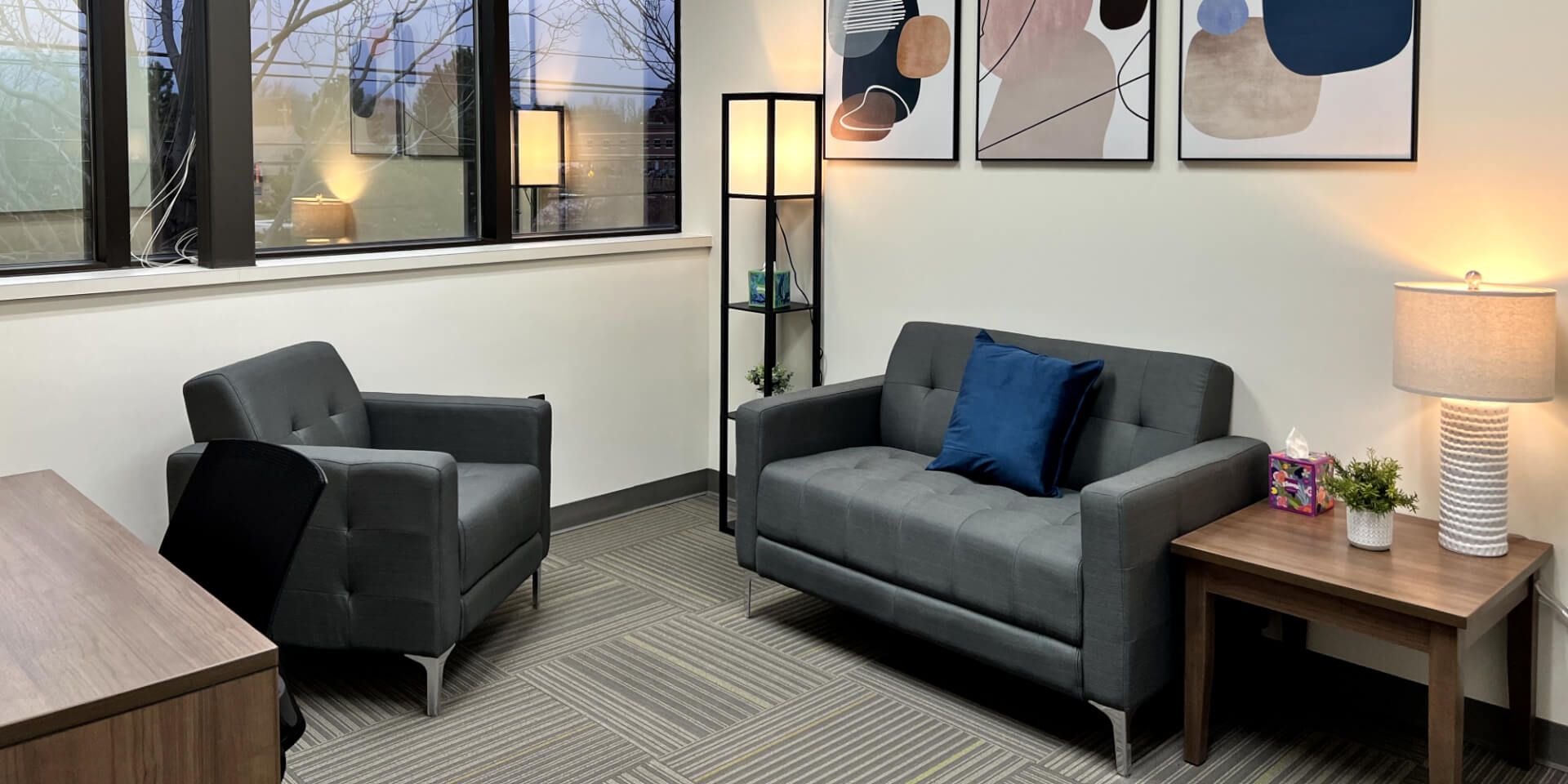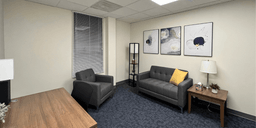Designing an Optimal Therapy Space for Healing
A therapy office is more than just a physical space; it plays a crucial role in the therapeutic process. The environment can significantly impact a client’s comfort level, willingness to open up, and overall experience. A well-designed office can foster a sense of safety and trust, which are essential for effective therapy.
So, what should you avoid in your office? Personal items in a therapy office may create a sense of bias or distraction for clients, and living or working- or attending therapy- in a cluttered environment can also affect cognitive function. Cluttered environments can increase stress levels by 40% , and the brain has to work harder to process information in a cluttered space, which can reduce productivity and impair decision-making abilities. This mental overload can contribute to feelings of fatigue and frustration. In addition to these psychological effects, clutter can also impact physical health. A cluttered space can harbor dust, mold, and other allergens, which can lead to respiratory issues and other health problems. This can further contribute to a sense of discomfort and unease in the environment.
Maximalism, characterized by an abundance of decor, colors, and items, can be overwhelming in a therapy office. An overly decorated space can distract clients from the therapeutic process, making it harder for them to focus on their thoughts and feelings. The visual clutter can also contribute to a sense of chaos, which is counterproductive to the calm and safe environment needed for effective therapy.
Creating a welcoming, calming, and professional office space is crucial for therapists. Your environment speaks volumes about your practice and can significantly influence the comfort and ease of your clients. Let’s explore some key strategies to ensure your therapy office is an inviting space for those seeking support and healing. A therapy office serves as a sanctuary for clients, providing a safe and comfortable environment where they can openly discuss their thoughts and feelings. The ambiance of the office can significantly impact a client’s ability to relax and engage in the therapeutic process.
Embracing minimalist design principles, maintaining cleanliness, and thoughtfully choosing decor can make all the difference. This guide will walk you through the essentials of setting up a space that promotes tranquility and professionalism.
7 Tips for Creating a Welcoming Therapy Office
Creating and maintaining an inviting office space is essential for any therapist. Your office is not just a place for therapy sessions; it is a sanctuary where clients should feel safe and comfortable. Most therapists know to avoid using overly bright or bold colors on the walls and furniture. These can be distracting and may evoke strong emotional responses, making it difficult for clients to relax and feel comfortable. But what else can you do to improve your space?
Here’s how you can achieve an inviting and effective therapeutic environment:
1. Choose Neutral Colors
Neutral colors serve as a calming backdrop, making the space feel open and uncluttered. Shades like beige, soft gray, and white can create a serene environment, reducing distractions and allowing clients to focus on their feelings and thoughts. Mindfully selected decor items, such as artwork and soft textiles, can enhance this calming palette. Items like nature-themed prints or subtle abstract designs can complement your chosen colors, fostering a sense of peace and reflection.
Using muted tones in your furniture and accessories helps maintain a minimalist aesthetic, contributing to a clutter-free and welcoming environment. These neutral hues not only relax clients but also provide a professional and polished look to your office space.
When adding accent colors, consider warm and soothing shades, like gentle yellows or soft purples. These can be introduced through pillows, rugs, or decorative objects, adding a touch of warmth without overwhelming the overall tranquility of the room. Remember, the goal is to create a harmonious and inviting atmosphere where clients feel at ease.
2. Incorporate Minimalist Design
A minimalist approach ensures that your space remains functional and free from unnecessary distractions. Invest in simple, clean-lined furniture and decor. Remember, less is more – follow Marie Kondo’s principle of keeping only items that spark joy or serve a purpose.
A minimalist office can help therapists maintain their own mental clarity and focus. By working in a clean, organized environment, therapists can better manage their own stress levels and avoid feeling overwhelmed. This, in turn, allows them to be more present and attentive during sessions, ultimately benefiting their clients.
3. Avoid Clutter
Clutter can create a chaotic environment. Keep your desk and shelves organized and free from too many personal items. This helps clients feel the space is professional and dedicated to their needs. Create a designated space for frequently used items. By having a specific spot for things like pens, notepads, and other office supplies, you can avoid having these items scattered around your workspace. Use desk organizers or trays to keep these items neatly contained.
A clutter-free space not only enhances the physical appearance of your office; it also reduces mental clutter for both you and your clients. Organize your documents and supplies neatly, perhaps in closed storage units to maintain a serene atmosphere. Clutter-free spaces help reduce anxiety and improve focus.
4. Prioritize Cleanliness
A clean office is non-negotiable. Regularly disinfect high-touch surfaces, vacuum carpets, and dust furniture. Not only does this promote a healthy environment, but it also shows clients you care about their wellbeing.
Encourage a ‘clean as you go’ policy. After each session, take a few minutes to tidy up the space, put away any used materials, and wipe down surfaces. This habit helps keep the office consistently clean and inviting.
Choose easy-to-clean materials for your office furniture and decor. Leather or vinyl chairs, for example, can be wiped down quickly, while washable rugs and curtains can be cleaned regularly to maintain a fresh environment.
5. Incorporate Multi-Functional Items
Using furniture and tools that serve multiple purposes can help maximize your office space. For instance, a stylish ottoman with storage capabilities keeps extra items hidden away while offering a place for clients to rest their feet or sit. Consider using a rolling chair (learn more about the benefits here). Digital devices like tablets and laptops can also be multi-functional. They can be used to access therapeutic apps, conduct teletherapy sessions, or provide clients with educational resources. These devices can help therapists integrate technology into their practice in a seamless and effective way. Additionally, a whiteboard can be invaluable for illustrating concepts during sessions or jotting down important notes while still looking aesthetically pleasing when not in use.
Multi-functional therapy items not only maximize the use of space but also contribute to a minimalist and organized environment. By incorporating items that serve multiple purposes, therapists can create a more efficient and adaptable office space that meets the diverse needs of their clients while maintaining a clean and clutter-free setting.
6. Avoid Personal Items
A personalized touch can indeed make a space feel uniquely yours, but it’s crucial to strike a balance. While a few items that reflect your personality or interests can help create a welcoming atmosphere, avoid overloading your office with personal memorabilia. Too many personal items may create distractions or inadvertently make your clients feel like they are in someone else’s space rather than a neutral zone where they can open up.
Choose minimal yet meaningful decorations, such as a neutral piece of artwork. Small elements that evoke a sense of calmness or inspiration can also be impactful. Remember, the focus should be on creating an environment that is inviting and comforting for your clients, allowing them to feel at ease while maintaining a professional ambiance. Minimizing personal items can help create a more inclusive space. Clients come from diverse backgrounds and may have different values and beliefs. A neutral space ensures that no one feels alienated or judged based on the therapist’s personal tastes or affiliations.
By keeping personal items to a minimum, you allow more space for your clients’ experiences and stories to take center stage. This minimalist approach not only helps in reducing distractions but also promotes a sense of calm and clarity, which are essential components of an effective therapeutic environment.
7. Incorporate Natural or Soft Light and Plants
Natural light and plants can enhance the inviting feel of a therapy office.
Natural light can significantly enhance the ambiance of your office. Whenever possible, allow sunlight to fill the room by keeping windows unobstructed. The benefits are manifold: it can regulate circadian rhythms, promote calmness, and improve mood, creating a serene environment that is conducive to therapy. In addition to natural light, incorporating soft lighting with lamps can also contribute to a soothing atmosphere. Using diffused, warm lighting helps create a cozy and relaxed space where clients can feel comfortable and at ease.
Consider integrating plants into your decor. Fresh greenery can bring life into the space, reduce stress levels, and boost overall well-being. Popular choices include low-maintenance plants like succulents, spider plants, and peace lilies. These plants not only add a touch of nature but also require minimal upkeep. Or, opt for high-quality fake plants if you lack a green thumb. The color green is associated with nature and can create a sense of relaxation and renewal, making even fake plants beneficial.
Prioritize Client Comfort in Your Therapy Office
By carefully considering each of these elements, you can create a therapy office that is both aesthetically pleasing and functionally effective, ultimately contributing to the well-being and comfort of your clients. Don’t forget, though, that you and your experience are the most important parts of the therapeutic process!
Working with Great Lakes Psychology Group can provide therapists with numerous benefits. GLPG offers a supportive network and resources that can help you manage your practice more effectively. We provide administrative support, marketing assistance, and access to a community of like-minded professionals. This partnership allows you to focus more on providing quality care to your clients while benefiting from the infrastructure and support that GLPG offers.



